
Pollock or pollack is the common name used for either of the two species of North Atlantic marine fish in the genus Pollachius. Pollachius pollachius is referred to as "pollock" in North America, Ireland and the United Kingdom, while Pollachius virens is usually known as saithe or coley in Great Britain and Ireland. Other names for P. pollachius include the Atlantic pollock, European pollock, lieu jaune, and lythe or lithe; while P. virens is also known as Boston blue, silver bill, or saithe.
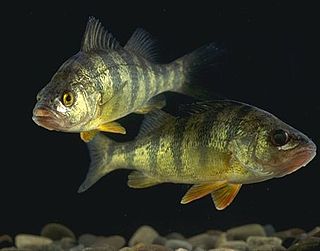
The Percidae are a family of ray-finned fish, part of the order Perciformes, which are found in fresh and brackish waters of the Northern Hemisphere. The majority are Nearctic, but there are also Palearctic species. The family contains more than 200 species in 11 genera. The perches and their relatives are in this family; well-known species include the walleye, sauger, ruffe, and three species of perch. However, small fish known as darters are also a part of this family.

The Squaliformes are an order of sharks that includes about 126 species in seven families.

Groupers are fish of any of a number of genera in the subfamily Epinephelinae of the family Serranidae, in the order Perciformes.

The Gonostomatidae are a family of mesopelagic marine fish, commonly named bristlemouths, lightfishes, or anglemouths. It is a relatively small family, containing only eight known genera and 32 species. However, bristlemouths make up for their lack of diversity with relative abundance, numbering in the hundreds of trillions to quadrillions. The genus Cyclothone is thought to be one of the most abundant vertebrate genera in the world.

Sander is a genus of predatory ray-finned fish in the family Percidae, which also includes the perches, ruffes, and darters. They are also known as "pike-perch" because of their resemblance to fish in the unrelated Esocidae (pike) family. They are the only genus in the monotypic tribe Luciopercini, which is one of two tribes in the subfamily Luciopercinae.
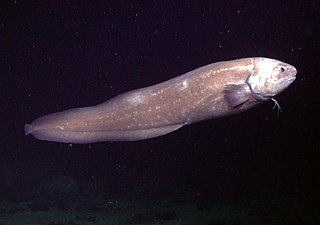
The cusk-eel family, Ophidiidae, is a group of marine bony fishes in the Ophidiiformes order. The scientific name is from the Greek ophis meaning "snake", and refers to their eel-like appearance. True eels diverged from other ray-finned fish during the Jurassic, while cusk-eels are part of the Percomorpha clade, along with tuna, perch, seahorses and others.

Notothenioidei is one of 19 suborders of the order Perciformes. The group is found mainly in Antarctic and Subantarctic waters, with some species ranging north to southern Australia and southern South America. Notothenioids constitute approximately 90% of the fish biomass in the continental shelf waters surrounding Antarctica.
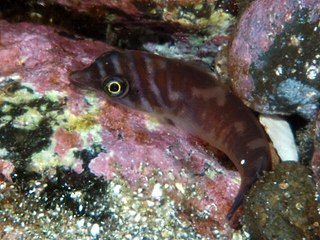
Clingfishes are ray-finned fishes of the family Gobiesocidae, the only family in the suborder Gobiesocoidei of the order Blenniiformes. These fairly small to very small fishes are widespread in tropical and temperate regions, mostly near the coast, but a few species live in deeper seas or fresh water. Most species shelter in shallow reefs or seagrass beds, clinging to rocks, algae and seagrass leaves with their sucking disc, a structure on their chest.
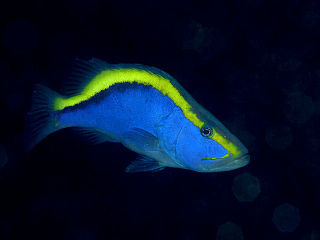
The goldribbon soapfish, also known as the goldribbon cod, blue and gold soapfish, gold ribbon grouper or goldstripe groper, is a species of marine ray-finned fish, related to the groupers and included in the subfamily Epinephelinae which is part of the family Serranidae, which also includes the anthias and sea basses. It is found in the Indo-Pacific region.
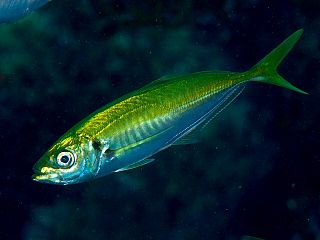
Jack mackerels or saurels are marine ray-finned fish in the genus Trachurus of the family Carangidae. The name of the genus derives from the Greek words trachys ("rough") and oura ("tail"). Some species, such as T. murphyi, are harvested in purse seine nets, and overfishing has sometimes occurred.

Gymnocephalus is a genus of ray-finned fishes from the family Percidae, which includes the perches, pike-perches and darters. They are from the Western Palearctic area, although one species, Gymnocephalus cernua has been accidentally introduced to the Great Lakes region where it is regarded as an invasive species. They have the common name "ruffe" and resemble the true perches in the genus Perca, but are usually smaller and have a different pattern.
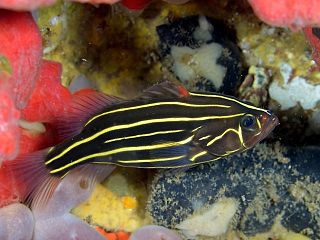
The goldenstriped soapfish, also known as the lined soapfish, golden-striped bass, radio fish, sixline soapfish, six-lined perch or white-lined rock cod, is a species of marine ray-finned fish, related to the groupers and classified within the subfamily Epinephelinae of the family Serranidae. It has a wide Indo-Pacific distribution.

An anchovy is a small, common forage fish of the family Engraulidae. Most species are found in marine waters, but several will enter brackish water, and some in South America are restricted to fresh water.

Rypticus is a genus of marine ray-finned fish, related to the groupers and classified within the subfamily Epinephelinae of the family Serranidae. It is one of several genera of soapfishes. These fish live in the Atlantic and eastern Pacific Oceans in tropical and warmer temperate zones.

Diploprion bifasciatum, the barred soapfish, also known as the double-banded soapfish, two banded grouper, two-banded sea perch, two-banded soapfish, yellow emperor or yellow striped grouper, is a species of marine ray-finned fish, related to the groupers and included in the subfamily Epinephelinae which is part of the family Serranidae, which also includes the anthias and sea basses. It is found in the Indo-Pacific region.
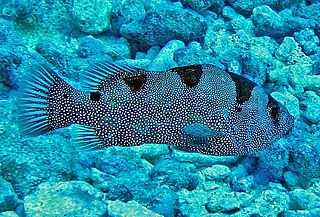
Pogonoperca is a genus of marine ray-finned fish, related to the groupers and classified within the subfamily Epinephelinae of the family Serranidae. They are found in the Indo-Pacific region.

Pogonoperca ocellata, the Indian soapfish or snowflake soapfish, is a species of marine ray-finned fish, related to the groupers and classified within the subfamily Epinephelinae of the family Serranidae. It is found in the Indian Ocean.
The ocellate soapfish is a species of marine ray-finned fish with a wide Indo-Pacific distribution. It is the only species in the genus Grammistops. It is also known as the ocellated soapfish, ocellated podge, or false-eyed soapfish. The specific name ocellatus refers to the ocellate (eye-like) spot on the operculum.
Grammistins are peptide toxins synthesised by glands in the skin of soapfishes of the tribes Grammistini and Diploprionini which are both classified within the grouper subfamily Epinephelinae, a part of the family Serranidae. Grammistin has a hemolytic and ichthyotoxic action. The grammistins have secondary structures and biological effects comparable to other classes of peptide toxins, melittin from the bee stings and pardaxins which are secreted in the skin of two sole species. A similar toxin has been found to be secreted in the skin of some clingfishes.



















